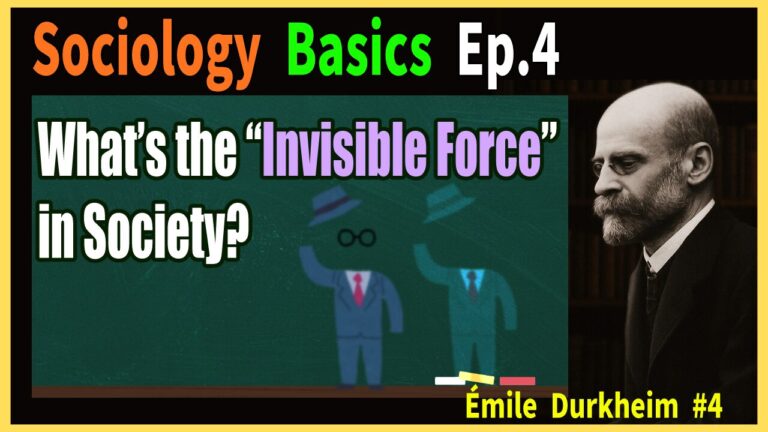Summary in the Video
Explanation in the video
The ‘Overview, Summary, or Conclusion’ of this article can be found at the beginning of the YouTube video, so please refer to it.
If possible, we would appreciate it if you could subscribe to our channel to help maintain the site. It serves as motivation for us!
(2-1) Introduction
This video series is structured around four major works by Émile Durkheim.
- The Division of Labor in Society (1893)
- The Rules of Sociological Method (1895)
- Suicide: A Study in Sociology (1897)
- The Elementary Forms of Religious Life (1912)
First, here is the overall structure of Durkheim’s The Division of Labor in Society.
This video focuses specifically on the topic of collective consciousness and collective representations.
The remaining topics will be discussed in the next video.
If you find this video helpful, please consider subscribing to the channel. It will motivate me to create the next one.
- Chronology
- What are the bonds that connect people to one another?
- What is division of labor and what are its functions?
- Why does division of labor produce social solidarity?
- [Column] What is sociology?
- The difference between mechanical solidarity and organic solidarity
- The difference between segmentary society and organized society
- Collective conscience and collective representations
- [Column] What is sociological theory?
- Examination of solidarity: repressive law and restitutive law
- Non-contractual elements in contracts
- A society without crime is unhealthy
- [Column] Durkheim’s critique of Tönnies
- Is individualism detrimental to solidarity?
- Coercive division of labor and anomic division of labor
- Intermediate groups as a measure against the adverse effects of modernization
(2-2) Collective Consciousness
In simple terms, it refers to the shared ways of thinking and feeling among members of a society.
For example, in American society, many people share the belief that children should become independent once they reach a certain age.
After the publication of Suicide, the term collective consciousness came to be used less frequently.
(2-3) Collective Representations
POINTCollective representations (French représentations collectives):a term that means the way in which a group thinks about itself in relation to the objects it considers significant, as defined in The Rules of Sociological Method.
This term has been more commonly used since the publication of Suicide.
The Difference between Collective Consciousness and Collective Representations
According to the sociologist Michio Nakajima, collective consciousness and collective representations are essentially the same in meaning, and there is little significance in distinguishing between them.
This is because both concepts include not only cognitive elements but also moral and religious dimensions.
Durkheim used the term collective consciousness less frequently because he wanted to give a new theoretical status to the concept of collective representations.
While collective consciousness referred broadly to beliefs and sentiments shared by the average members of an entire society, collective representations were used to describe more differentiated and specific forms of consciousness.
For example, these may include shared ideas and values held uniquely by groups such as doctors, politicians, or Protestants.
In general, the term representation means the symbolic expression of the meaning or image associated with something.
In other words, it refers to the attempt to make something invisible visible in some form.
If we understand collective representations as the visible forms of collective consciousness, I begin to wonder whether there might be some merit in distinguishing between the two.
It may be the case that the term external social facts (or external indicators) is more appropriate for embodying the meaning of representation than the concept of collective representations itself.
If we understand collective consciousness and collective representations as differing only in scope or degree of differentiation, and if we consider both as internal social facts that can be identified through external social facts (or external signs), the overall picture becomes somewhat clearer.
Durkheim distinguishes between internal social facts, which are invisible, and external social facts, which are visible.
For example, social solidarity is an internal social fact because it is not directly observable.
The problem lies in how to prove its existence.
The clues to this proof come from external social facts, such as statistical data that objectively represent averages or other measurable indicators.
References
Recommended Readings
Emile Durkheim「The Division of Labor in Society」
Emile Durkheim「「The Division of Labor in Society」
DK Publishing, Sarah Tomley「The Sociology Book: Big Ideas Simply Explained (DK Big Ideas) (English Edition)」
About the Japanese version of this article
This article is a translation of an article written in [https://souzouhou.com/2024/11/27/durkheim-4-1/]. For detailed references, please refer to this link.




Comments